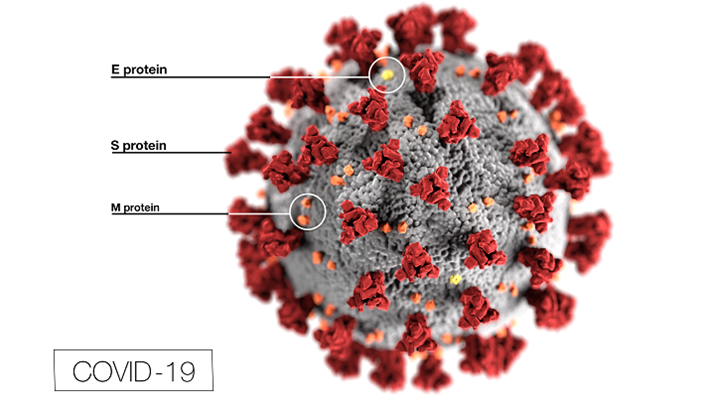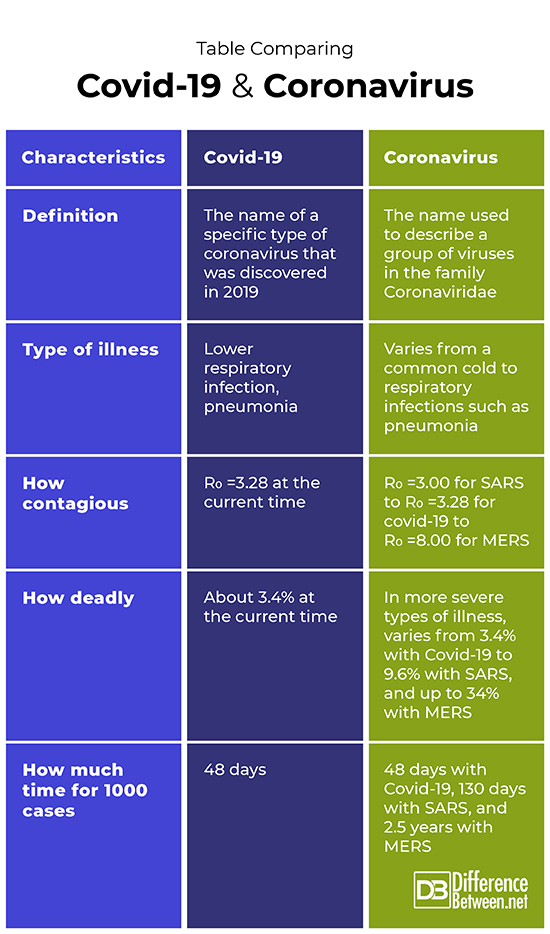Difference Between Covid-19 and Coronavirus
Covid-19 is the term used to describe a specific virus that was discovered in 2019. Coronavirus is the term used for a group of viruses that have a crown-shaped appearance and are in the Coronaviridae family.

What is Covid-19?
Definition:
Covid-19 is the name for novel coronavirus, which was first noted in Wuhan in China in late 2019.
Countries in which cases have occurred:
The covid-19 illness has now been classified as a pandemic by the World Health Organization since it has spread worldwide. The first country that cases were recorded in was China, but the viral infection has spread globally largely due to people traveling.
Type of illness caused:
Covid-19 causes an unusual type of pneumonia that greatly compromises a person’s ability to breathe. The symptoms related to this include a dry rather than a wet cough, a high fever, and extreme fatigue. People may struggle to breathe due to fibrosis of the lungs. ARDS and eventually multiple organ failure and death can occur.
Structure of virus:
The covid-9 virus has a crown-shaped appearance with E and M proteins on the outermost surface. Proteins have also been discovered that help the virus to copy itself; these polypeptides are called nsp3 ADP ribose phosphate, nsp15 endonuclease, and nsp9 replicase.
How contagious and deadly:
The virus covid-19 is known to be more contagious than the influenza virus, but less contagious than the measles virus. An estimate of the infection rate uses the symbol Ro. This gives the number of cases of infection that can initially originate from one individual who is ill. In the case of covid-19, some recent research indicates that the Ro = 3.28. This means on average that each person could transmit the virus to 3.28 other people, and the mortality rate is currently averaging about 3.4% according to the WHO, but this varies with the age group.

What is Coronavirus?
Definition:
Coronavirus is a general term used to describe a group of viruses all in the family Coronaviridae that all have a particular crown-shaped morphology.
Countries in which cases have occurred:
The coronaviruses have caused illnesses in people in various countries around the world. While SARS was mainly limited to China, and MERS, to the Middle East, this is not the case for Covid-19 which is now a pandemic.
Type of illness caused:
Coronaviruses in general, are found in several groups of animals, and usually cause some type of respiratory disease. Illnesses such as MERS and SARS, as well as covid-19 are all caused by some kind of coronavirus. These are also believed to be zoonotic diseases meaning that the virus jumped from an animal host into humans and then human-to-human transmission occurred.
Structure of virus:
All coronaviruses have an envelope surrounding the genetic material, the RNA, of the virus. There are also spikes made out of sugars and fats that stick out from the outer surface of the envelope.
How contagious and deadly:
The level of contagion varies a great deal depending on the type of coronavirus involved. In some cases, the Ro is about 3.00 but in other cases Ro is as high as 8. Mortality rates are also variable ranging from 3% with SARS to 34% with MERS.
Difference between Covid-19 and Coronavirus?
Definition
Covid-19 is the name of a specific type of coronavirus that was discovered in 2019. Coronavirus is the name used to describe a group of viruses in the family Coronaviridae.
Type of illness
Covid-19 causes a lower respiratory infection often resulting in pneumonia. A coronavirus can cause an illness that varies from a common cold to more severe respiratory infections such as pneumonia.
How contagious
The covid-19 virus has an Ro =3.28 at the current time. The coronaviruses vary in contagiousness depending on the type, with Ro =3.00 for SARS to Ro =3.28 for covid-19 to Ro =8.00 for MERS.
How deadly
The death rate of covid-19 is about 3.4% at the current time. The death rate of coronavirus varies by type from 3.4% with covid-19 to 9.6% with SARS, and up to 34% with MERS.
How much time for 1000 cases
It takes about 48 days for there to be 1000 cases of covid-19 based on present data. There is a range of time to reach 1000 cases, with coronaviruses depending on the type; it takes 48 days with covid-19, 130 days with SARS, and 2.5 years with MERS.
Table comparing Covid-19 and Coronavirus

Summary of Covid-19 Vs. Coronavirus
- Covid-19 is a specific type of virus that was only discovered in people in 2019.
- Coronavirus is the name used for more than one type of virus which has a crown-shaped structure due to the structures on the outside surface of the virus.
- The mortality rate of covid-19 is generally about 3.4%, but it varies with age with older individuals more likely to have complications and not survive.
- Types of coronavirus include covid-19, MERS and SARS.
- Coronaviruses vary a great deal in how contagious and easily spread they are and how deadly they are.
- Difference Between Constipation and Bowel Obstruction - April 3, 2024
- Difference Between Constipation and Diarrhea - March 30, 2024
- Difference Between Cellulite and Stretch Marks - March 25, 2024
Search DifferenceBetween.net :
Leave a Response
References :
[0]Image credit: https://en.wikipedia.org/wiki/File:3D_medical_animation_coronavirus_structure.jpg
[1]Image credit: https://health.mil/-/media/Images/MHS/Photos/COVID-19.ashx?h=407&la=en&mw=720&w=720&hash=332EAD54CFF5B415044711D1F966B399F05E032CA7CFA38CC61CB42EA88753AE
[2]Cascella, Marco, et al. "Features, Evaluation and Treatment Coronavirus (COVID-19)." StatPearls [Internet]. StatPearls Publishing, 2020.
[3]Kim, Jeong-Min, et al. "Identification of Coronavirus Isolated from a Patient in Korea with COVID-19." Osong Public Health and Research Perspectives 11.1 (2020): 3.
[4]Liu, Ying, et al. "The reproductive number of COVID-19 is higher compared to SARS coronavirus." Journal of travel medicine (2020).
